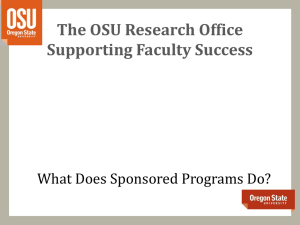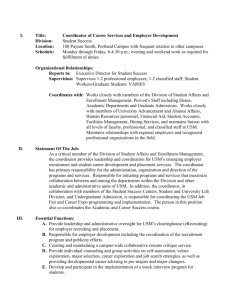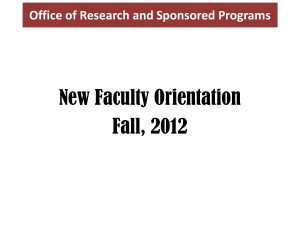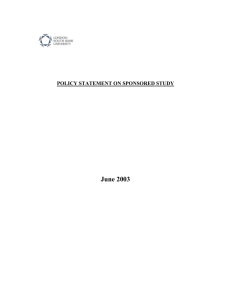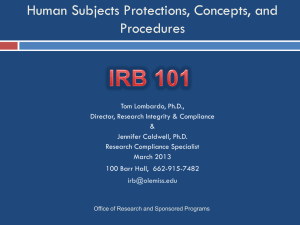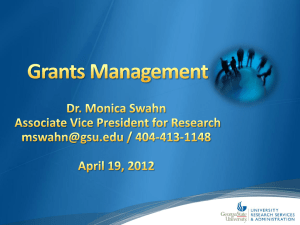Assessment of the Research Administration Function
advertisement
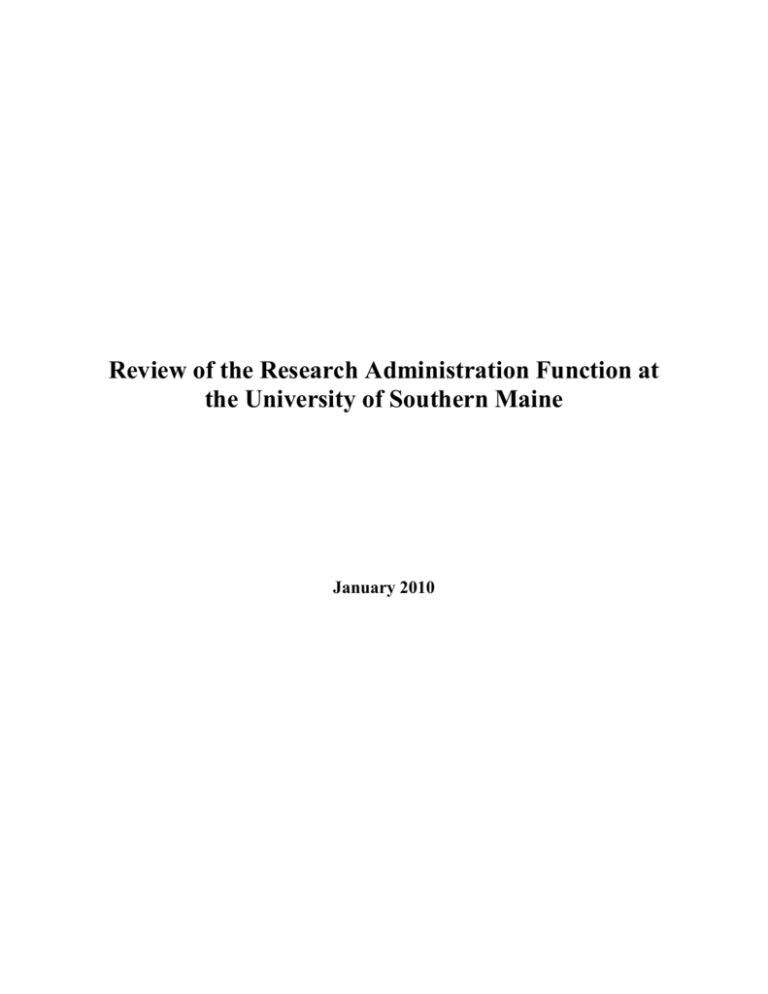
Review of the Research Administration Function at the University of Southern Maine January 2010 OVERVIEW The University of Southern Maine has a research program of approximately $45 million dollars. There is a commitment to research and scholarship at the University and by the State of Maine. However, the perception of many people we talked to is that there is no clear research mission at USM. There are two distinct areas of research at USM. The bulk of the research dollars, about $30 million is generated by The Edmund S. Muskie School of Public Service. This Institute has four inter-related programs: Justice Policy, Disability and Aging, Population Health and Health Policy, and Children Youth and Families. Their funding is derived from a number of sources which include state 61%, direct federal 18%, foundation 9% and other 12%. The Muskie School has an administrative support team in place and does not rely solely on the Central Research offices for support. Their Institute Redesign Report in January 2009 shows a desire and need for quality assurance efforts in proposal development, product development and research compliance (HIPPA, IRB, other regulatory requirements). It is interesting to note that even with a robust central research compliance team they identified a need to have an institute IRB point person. The second largest program would be the Biosciences Programs. In 1998 USM set on a path to build scientific research that would support economic development. It was brought about by the Maine Economic Stimulation Bond that promised to “raise funds to support applied research and development in biotechnology, aquaculture and marine sciences, information technologies, advanced materials and advance technologies for forestry and agriculture”. In 2000, a bond was issued by the state to provide an initial $5 million for the Science Building Lab Renovation, designed to be a premier bioscience research facility. Phase one was completed at this time. There was expansion of this space in 2003. The final phase of construction took place in 2006 with funding by the U.S. Department of Energy for the Toxicology Center that allowed a new laboratory and office suite on the fourth floor of the building. No further funds have been allocated for finishing the 3rd, 4th and 5th floors. While there is occupancy by ASET (Applied Medical Sciences, Computer Science, Technology), and CAS (Psychology, Biology, Chemistry, Philosophy), the rest of this research space is occupied by the Maine Center for Enterprise Development and the Maine International Center for Digital Learning, and the Maine Space Grant Consortium. Sponsored program activity is supported by the Office of Research Administration and Development that includes the following three offices; Research Administration and Development, Sponsored Programs, and Research Compliance. These three groups provide leadership and coordination for strategy and policy, compliance with fiscal and legal regulation, institutional reporting, administrative services for researchers, student research programs, the university research council and the management of the State MEIF resources. We were charged to assess the state of the research infrastructure to include the units of Research Administration and Development, Sponsored Programs and Research Compliance. We were specifically charged to address the following questions: Is USM Research Administration organized and staffed appropriately for the needs of campus? Should Sponsored Programs have direct reporting to the Office of Finance and Administration for post-award services? What are the skills and roles most need in USM’s research leadership (a VP research position)? Additional questions posed to us during our visit included whether or not the structure was appropriate for a comprehensive University, and if the research profile seemed appropriate. Related to this question was how research fit in to the mission at USM. Both faculty and staff wondered what they were really supposed to be doing and what were the goals they should strive to reach. Faculty and staff wonder what the institutions commitment was to the research endeavor. A final set of more specific questions we considered based on our interviews are: What is customer service like in Research Administration? With little information available to the faculty on grant and contract opportunities, how can the pre-award better help faculty figure out what is available? How can the post-award group help faculty account for and spend their money? What is the right number of staff for the volume of research currently at USM and does that staff have the proper skill sets? What does it cost to run the Animal Facility and what money is generated by investigators? How are the indirect cost funds accounted for, and how are decisions made regarding how those funds are expended? Is there a clear University wide class release policy that is consistently applied? EXECUTIVE SUMMARY The primary objective was to provide an organizational assessment of the research infrastructure, i.e., Research Administration & Development, Sponsored Programs and Research Compliance. In the course of our discussions with key campus constituencies, we also explored their understanding of the campus’ research mission and ways to enhance the research infrastructure. We conducted a high-level review of Research Administration & Development, Sponsored Programs and Research Compliance. Processes reviewed included: Proposal development, review, approval and submission Award acceptance and set-up Postaward Administration Research Compliance Research Operations USM’s Funding Trends (FY09 vs. FY08) The total amount of sponsored funding awarded grew nearly 6.0% from $42.5M to $44.9M while the total number of awards decreased by 8.0% to 162 awards. The total value of proposed funding has decreased by 2% to $76.4M while the total number of proposals increased from 252 to 259. The number of proposals submitted by the Muskie School increased by 20% while the number of awards decreased by 20%, and the funding was flat. This accounts for the largest percentage of extramural funding awarded to USM in FY09. Recent Improvements USM has achieved several recent accomplishments and improvements in its research administration enterprise. Examples include: 1. In an effort to provide a greater level of service to the campus, OSP has recently instituted a proposal submission policy. 2. Departmental and faculty personnel indicated that the quality of service has improved over the last few years. 3. Publication of the first annual report highlighting research activities at the University. 4. An access database has been developed to assist with grants administration. The limiting feature is that it does not communicate with the PeopleSoft system. 5. The UMaine system had implemented scanning technology to store pre and post award documents. 6. The Office of Research Compliance (ORC) led the USM IRB to national recognition as an IRB Best Practices site, designated by Public Responsibility in Medicine and Research (PRIM&R). This is a notable achievement but not an accreditation. Challenges Although improvements have been made over the last few years, in order to provide a supportive environment for research and sponsored projects, the University of Southern Maine (USM) must rethink its institutional culture and decision-making and consider modifying some aspects of the administrative structure. Several key factors that have contributed to the current environment include: 1. The university culture is undergoing a significant transition. The impact of this transition if reflected in the current attitudes, policies and procedures. 2. There is a lack of clarity about research and where it fits within the overall institution’s mission, i.e., research isn’t harmonized with the academic mission. 3. There is little incentive for faculty to engage in research. 4. USM has made a significant investment in research administration particularly in the areas of research compliance and research operations. It is unclear that these investments have increased efficiency and promoted research growth. 5. The relationship between the Office of Sponsored Programs (OSP) and the departments/faculty is often strained. OSP is seen as focusing more on “compliance” as opposed to “service” while the departments/faculty are often perceived as lacking an understanding of potential consequences of non-compliance. 6. There are very few department administrators available to assist faculty in either pre or post award administration. Many administrative burdens fall onto the faculty leaving them with little time to attend to the programmatic aspects of the sponsored program. 7. Roles and responsibilities are not clearly defined and communicated and faculty are confused not only about “whom to call” for assistance, but what assistance is available. 8. There is no formal performance measurement system for the research administration enterprise. 9. There is a perception that OSP is unwilling to delegate authority to departmental administrators who are willing and eager to accept the authority. RECOMMENDATIONS A major focus of this report is increasing administrative support for research and sponsored projects and retooling the infrastructure to increase efficiency and promote growth. However, it is critical that these recommendations be grounded within a larger University vision and mission for research and sponsored projects. 1. A statement of vision and commitment to research needs to be generated by the University administration in collaboration with Deans and faculty. 2. In a climate of continued fiscal challenge and increasing needs for accountability it is more important than ever to offer faculty incentives that advance progress toward college and university goals as well as to the overall mission. Incentives can take many forms including: 1. Financial Incentives o Release Time o Internal grant competitions o Student support o Funding to attend meetings o Professional development o A portion of indirect returned to college/department and PI o Departmental administrative research support at established thresholds 2. Non-financial incentives o Mentoring program o Helping faculty with proposal development o Interdisciplinary research opportunities o Recognition (e.g., awards) 3. The reporting relationship between Research Administration & Development, the Office of Sponsored Programs and Research Compliance Office should be clarified. For example, each unit has a separate website showing limited to no connection to the other units. We would recommend that the entire Research Administration enterprise report to the Associate Vice Provost Research (AVPR). In addition, OSP (post award activities) should have a dotted line to the Chief Financial Officer for compliance and audit purposes. The need for a separate unit to manage the MEIF funds and research operations should be evaluated. The structure and FTE recommendations would look as follows: Associate Vice Provost, Research Chief Financial Officer Director, Research Administration Research Compliance 2 FTE Research Operations (see Reviewing the Process below) Sponsored Programs 1 FTE Pre Award 2 FTE Post Award 6 FTE Reporting to the Provost, the Associate Vice Provost for Research (AVPR) would assume overall administrative responsibility for developing, coordinating, and stimulating research and creative activity at USM; for enhancing external funding; and for ensuring compliance with all applicable laws and regulations. The Associate Vice Provost for Research would be expected to increase and diversify research and creative works, extramural funding, public-private partnerships and technology transfer. Particular emphasis should be given to expanding PUI (Primarily Undergraduate Institution) opportunities; interdisciplinary and intercampus research. The AVPR should oversee the allocation of the MEIF. The monies should be used to support research funding initiatives including faculty research development programs; furthering development of research space, funding for undergraduate students, and faculty start-up packages. We would also suggest the implementation of a budgeting process that promotes accountability and transparency for MEIF fund recipients. MEIF fund recipients should be required to demonstrate progress against specific goals as a recipient of these funds. The Associate Vice Provost for Research should represent and advocate for the University’s research enterprise both regionally and nationally. The AVPR should develop strong working relationships within the University community; with the other campuses in areas of research collaboration; with local and national businesses and industries; and with state and federal granting agencies. We would recommend that the Research Council work with the AVPR as an advisor in support of the research enterprise. For example, the University Research Council could be given overall responsibility to recommend mechanisms to develop, promote and administer the research programs of the University in order to strengthen excellence in research. Reporting to the AVPR, the Director, Research Administration should be the position with ultimate responsibility for the day-to-day operations of the Research Administration enterprise. The Director, Research Administration should oversee the functions of Research Compliance, Sponsored Programs and Research Operations. 4. Research Administration should better define and strengthen their customer service model for providing support to the Principal Investigators and research staff. Their focus should be to provide excellent customer service from submission of a proposal to closeout of the award. Recognizing that Sponsored Programs and Research Compliance has a dual and sometimes conflicting role of customer service agent and institutional oversight agent, both functions should strive to provide excellent customer service within the constraints of state and federal regulations. What does good customer service mean? It means that before telling a PI that a certain transaction cannot be executed, try to understand what the PI is asking and then proposing alternatives that work within the constraints of the regulations. Other actions that USM should consider to strengthen the customer service model for research administration support: i. Ensure that research administration develops a mission statement and goals. ii. Hold regular meetings with departmental administrators, faculty and research administration to build a research community and to strengthen all administrative aspects of the research endeavor. Central administrators, departmental administrators and faculty each have a unique perspective and skills. In the most successful colleges and universities, they work together as a team to efficiently complete the administrative tasks and free the faculty (PI) to complete their funded research. iii. The website should include staff assignments by college/department/PI. iv. Mandate customer service training for all employees in research administration. v. Create performance metrics for certain tasks such as how long it takes to review a proposal, set up a new account number, or track the number of late financial reports. 5. Develop a research administration roles and responsibilities matrix to better define roles and responsibilities across central and departmental units. A frequent refrain that we heard from OSP is “that function belongs to the Principal Investigator” however, it is not clear that the Principal Investigator fully understands the implication of accepting these responsibilities, nor does he/she have the time and/or expertise to meet OSP standards. The roles and responsibilities matrix should address the following areas: Proposal Development and Budgeting Proposal Review, Approval and Submission 6. Award Acceptance and Account Set-up Protocol Review, Approval and Monitoring Conflict of Interest Financial Management of Awards Award Close-Out Improve the consistency of departmental staffing for research administration support. The Muskie School model, i.e., dedicated local research administrative support could be applied to the larger units, e.g., ASET. For smaller colleges/departments, a shared college-based model could be used. This inconsistent level of support in colleges impacts the workload of OSP. With few exceptions, it is clear that most administrators within the colleges/departments have significant responsibilities outside of research administration, and in fact offer little administrative research support. The grants environment is very compliance-focused and requires specific knowledge and expertise. It would be helpful to Principal Investigators to have a “go to” administrative person. We would suggest the National Council of University Administrators (NCURA) – Region I for training for both central and department administrators. Personnel within the current Research Administration enterprise could be reassigned to provide day-to-day support at the college/department level. Reviewing the Process OSP The director manages both pre and post award functions. This group worked independently for many years, although they began reporting to the Director of Research Administration in the last 6 or 7 years. Pre-Award Recommendations For the purposes of this report, pre-award is defined as those activities up to and including proposal submission. There was some frustration expressed by both faculty and staff about the proposal review and approval process. Some of this frustration can be traced to a lack of administrative support within the college/departments and some of it can be traced to the need to deal with multiple staff within the OSP for the proposal submission process. In addition, the Pre-Award office needs to be more responsive to the requests of the Principal Investigator. To improve the process, USM should consider the following: Assisting with Proposal Development The preaward office does a good job at assisting individual faculty members in the identification of funding opportunities. Service to faculty could be enhanced through use of some or all of the following suggestions: o Dissemination of Funding Information: USM subscribes to the Community of Science Database. Faculty members should be encouraged to subscribe (and be trained) to the electronic notification service. o Take advantage of the “So Noted” electronic newsletter by including more relevant funding opportunities. o Hold one or two topical workshops during the academic year. Typical topics cover subject such as budget preparation, proposal submission processes, proposal review and funding information. Because it can be difficult to get faculty attendance at training sessions, consider conducting the workshops at a specific college or department. Reviewing and Approving Proposals: o Tracking Forms: There are currently two internal forms required with proposal submission. Consider merging the two internal proposal forms into one form. o Proposal Budget: The development of the proposal budget should be shifted from the post-award office to the pre-award office. In addition, it should be a priority of the pre-award office to ensure that budgets are checked for computation; the proposal complies with sponsor guidelines; and with university policy. o Proposal review: Valuable staff time is lost by OSP staff (and the Principal Investigator) in the review and edit of the technical proposal. Consideration should be given to offering editing as a service, when requested, not as a requirement. In addition, the technical merits of the proposal should be left to the department chair and college dean. o Sponsor Familiarity: The staff needs to become familiar with all the funding agencies to which proposals are submitted. The sponsor’s website generally provides very specific information. It may also be appropriate to reach out to other campuses or colleagues that are familiar with a particular sponsor. Should more formal training be required, consider training offered by the National Council of University Administrators or the Society of Research Administrators. Staffing Requirements: The Pre-Award function currently has 2 FTEs. In 2005, Huron consulting conducted a research administration staffing benchmark study for non-medical research universities. The study suggests an average of 121 proposals per FTE. In FY2009, USM submitted 259 proposals, an average of 129.5 proposals per FTE. The staffing level appears appropriate for the level of activity. Post Award Post Award administration happens after a proposal is submitted and an award is made. This area covers a multitude of policy issues and processes both financial and non-financial. When an institution accepts an award, in addition to conducting the work proposed, the institution also agrees to be a good steward of funds. Communication between OSP and the faculty/financial administrators is often problematic, resulting in misperceptions and misunderstanding. Largely, faculty are asked to manage their own grants and they feel it is expected that they understand budgets and accounting. As an example, investigators told us that they are asked to make collection calls if an invoice amount has been outstanding for more than 60 days. There is a lot of duplication of effort between OSP and the UM Systems Office to get awarded grants activated for the PI. The UMS Shared Services Advisory Council is reviewing the PeopleSoft Grants module for implementation. This would help reduce duplication of effort between OSP and the UM Systems Office and reduce frustration with perceived inefficiencies around campus. To improve the process, USM should consider the recommendations contained in the Price Waterhouse Coopers report. We will not reiterate them but suggest that priority be given to the following: Award Set-Up: We concur with the Price Waterhouse Coopers report that recommends the enhancement of communication and streamline business processes between the System Office and the campus. Faculty frequently mentioned that there is a lengthy delay in the project set-up process. We would strongly advocate that the campuses be given the authority to establish their own accounts. Review the governance structure and evaluation of job roles and responsibilities in pre and post award. PIs informed us that they did not know whom to call when they had a question yet OSP informed us that staff are assigned by college/department/PI. The missing piece could be that the staff assignments are not published on the website. In addition to posting assignments on the OSP website, we would recommend that the current workload assignments be evaluated for equity and parity. Requirement that PIs perform a monthly financial reconciliation: We agree that sponsored program accounts should be reviewed monthly. This actually leads to more compliance issues as this could lead to increased cost transfers. We would suggest that a much gentler, service-oriented approach be used to gain buy-in from PIs and other administrators. The first step in this process is establishing a collaborative, serviceoriented culture within OSP. Dotted Line reporting relationship to the Chief Financial Officer: Sponsored research projects at USM, which are made possible by federal, state and private awards require the support of thorough and ethical accounting and reporting for post-award dollars. In addition, OSP oversees the accounting, invoicing, fiscal management and effort reporting for each of USM’s sponsored projects. It is important that OSP – post award have a dotted line responsibility to the CFO to ensure proper stewardship and management of sponsored program funds. Staffing Requirements: Excluding the Director, the Post-Award group has a total of 6 FTEs. Three grant accountants spend approximately 30% of their time to preparing proposal budgets and 70% on postaward activity. As previously suggested, more efficiencies and better service could be realized by shifting the budget preparation activity to the preaward office. This should allow the grants and contracts accountants’ additional time to provide more postaward assistance to investigators. The office is also supported by an Administrative Assistant who keeps the database current and works with the system office on account set-up. The Huron benchmark study suggests that an average of 88 awards are managed by one FTE. The average dollar expenditure volume per FTE is $8.7M. Using this guideline, we would recommend a maximum of 4 FTEs in the grant and contracts accounting role who are responsible for all post-award activities related to their assigned funded projects. The database specialist supports the office’s database activity. There are many ways to staff research administration offices and we would suggest the following: a. 2 FTE pre-award people to review proposals and provide search services. By review proposals we mean to review the budgets for accuracy and the administrative sections for completeness. The scientific sections should only be reviewed by OSP for font size, adherence to page limitations and the requirements of the specific RFP. b. 4 FTE post-award people to handle all post-award financial and compliance activities. Monthly reports review, time and effort reporting, re-budgeting requests, annual reports, closeout, etc., c. 1 FTE administrative assistant. d. 1 FTE database specialist. Compliance The Office of Research Compliance provides review and oversight of human subject research projects, staffing and administrative support to the Institutional Review Board (IRB), review and oversight of animal research, staffing and administrative support to the Institutional Animal Care and Use Committee (IACUC), support for the Radiation Safety committee, and support for the Institutional Biosafety Committee. The Compliance group is very proud to point out that ORC has led the USM IRB to national recognition as an IRB Best Practices site, designated by Public Responsibility in Medicine and Research (PRIM&R). The ORC devotes approximately 80% of its time to Human Studies work. They handle approximately 400 reviews a year, including a small number of fee-for-service and from other U Maine research groups. Of these, 8-10 requires full board approval because they present more than minimal risk to subjects. The rest of the protocols are either exempt or expedited. Most of their proposals come from the School of Social Work. The second biggest customer is the Muskie school with about 38% of the remaining protocols. Several investigators mentioned that the ORC does not notify them in advance impending deadlines, e.g., protocol continuing review. To improve service, ORC should send out renewal notices, sixty or thirty days in advance of the due date. Faculty expressed a view that ORC “digs up obscure regulations” that have no applicability to the research being conducted. There was a sense that ORC views themselves as the conscience of the University. The ORC should be an office that promotes a culture of compliance, research integrity and high quality research within the university community. The ORC should facilitate research by providing coordination of research compliance areas involving human subject, animals and hazardous agents. The ORC should not be empowered to act on behalf of any institutional compliance committees. Three FTEs provide the review and oversight of “complex human subject research projects.” These are the Director, Associate Director, and the Analyst for Research Compliance. They also provide an educational component to every meeting of the IRB. The IRB meets monthly with or without a full board. Their additional role is in the classroom where they provide student orientation to human subject research. One FTE, an Administrative Assistant II, processes files, coordinates meetings and educational activities. In addition, this position fields incoming calls, emails, maintains the database(s), website and processes all incoming research protocols for review. There is an additional intern/student worker who devotes up to 15 hours a week for long term large-scale projects. Staffing Requirements: Two FTEs should be able to manage a research operation the size of USM. This could be augmented with continued student support. We compared this office to comparable and larger Universities to arrive at this recommended staffing level. Office of Research Administration and Development The Research Administration and Development Group oversee the day-to-day operations of the Bioscience wing including the core facilities. This group also provides administrative support for the Director of Research Administration and Development and other centralized research functions such as the research council and undergraduate summer research fund. The final member of this group is the Animal Facilities Manager. The group is supported through the MEIF allocation. The Operations group devotes most of its time to the Biosciences building. Research Operations is viewed by faculty as a luxury operation dedicated to supporting a “half-empty” building. The Research Operations group has two individuals that were hired initially to work on issues around building construction and maintenance. At this time, there is no active expansion of the Biosciences Building. However, we understand that there is a possibility for some funding to develop a new lab(s). One way to utilize your operations people who currently maintain the Biosciences building would be to have them available to the entire research community to help with building/space issues and solving the physical problems of running research laboratories. While they have a willingness to do so and in fact, have done so, this resource should be marketed more effectively. The Animal Facility is state of the art but terribly underutilized. It is worth noting that the facility manager is a nationally certified Manager of Animal Resources, and in fact, is the only such person in the state of Maine to have this designation. The animal facility has a budget of $168 K, which is offset by approximately $40K in reimbursements. We note that there is an effort to house animals for another school and have them participate in the cost of maintaining this facility. USM must leverage the expertise of this manager and try to house animals from other schools in the UM system or for other research institutions to make it a financially viable operation. Two administrators complete the group. An Administrative Manager and an administrative assistant. Staffing Requirements: Once the new AVPR is in place and priorities established it would be appropriate to review Research Administration & Development. The assessment should include the following questions: Is this a luxury that USM can afford? Is a separate infrastructure needed to support the building? Should this function (and the individuals supporting the facility) be folded into the Facilities department? How can the animal facility become a financially viable operation? Appendix Appendix A Findings The following is a representative sampling of comments/sentiments received during the interview process. Lack of attention forced people to assume more responsibility and authority then the roles dictate. Grants outside the norm throw OSP for a loop. OSP puts up barriers to proposal submission through strict enforcement of internal rules. OSP sends “nasty” notes if monthly reconciliations/time and effort reports are done on time. “One-off solutions to problems – not consistent” Research Compliance = “zero risk” environment. At the college level, activities in support of research efforts, if they exist, are often viewed as “extra.” When in search of assistance at OSP, research personnel feel the culture of compliance dominates. The faculty are frustrated with the amount of time they spend trying to resolve administrative issues. There are mixed signals coming from USM Administration. There is no incentive to get grant money. There needs to be a clear University release policy for research. Pilot funds are not available from the University. No mechanism on campus to create preaward accounts, which results in late starts, cost transfers and/or problems spending funds in a timely manner. There needs to be acceptable policy and procedures so that USM don’t make more commitments (including MEIF) than they can fund. There are currently many projects that undergrads could be part of for very little money but there are no funds to pay for them. There is little knowledge about corporate or foundation research, which might help with start up, or interim funding. Additionally, the University appears to “lock up” foundation proposals in the Development Office and make sure that no one approaches these foundations for research funding. While many see research focused on student involvement, the report “Preparing USM for the Future 2009-2014” states that there is a demographic shift in the student body with an older, working, student population. These types of students would not necessarily be part of the “research” group. Appendix B Participants Interviewed Name Title Department Baetz, Fritz Bola, Trish Contracts & Grants Accountant Admin Mgr, Aquatic Systems Group Office of Sponsored Programs Research Admin & Development Botman, Selma Brown, Alan President Operations Manager President's Office Research Admin & Development Campbell, Dick Carter, Judy Chief Financial Officer Database Specialist Finance & Admin Office of Sponsored Programs Day, Robin Duboise, Monroe Asst Dean For Finance & Admin Assoc Prof of Molecular Biology College of Education and Human Development Applied Medical Science Forhan, Kate Forstie, Clare Provost Grants & Contract Manager Provost's Office Muskie School Foster, Bill Fraumeni, Barbara Dean Assoc Dean & Prof of Public Policy & Mgmt Muskie School Muskie School Gibson, Joyce Gilliam, Sarah Dean Animal Facilities Manager Lewiston/Auburn College Research Admin & Development Gravelle, Renee Graves, Shannon Admin Asst II Admin Asst Research Admin & Development Office of Sponsored Programs Griffin, Eileen Harrison, Lliam Research Assoc II Director Muskie School Office of Research Compliance Hebert, Jenni Heimes, Rita Analyst Director, Center for Law & Innovation Office of Research Compliance Law School Hickey, Ross Johnson, Paul Assoc Director & IRB Coordinator Assoc Prof Office of Research Compliance Social Work Dept Langley-Turnbaugh, Samantha Maher, Chris AVP for Research Assoc Prof Provost's Office Biology Dept Markowski, Vince Martz, Nancy Assoc Prof Director Psychology Dept Research Admin & Development Moore, Lisa Mousseau, Tracey Assoc Prof Staff Assoc for Research Admin Biology Dept Office of Sponsored Programs Picinich, Sue Prudente, Caryn Dean Assoc Prof College of Arts & Sciences Chemistry Dept Reed, Gwen Rollins, Lynn Manager of Funded Accts Assoc Director of Pre-Award Svcs Office of Sponsored Programs Office of Sponsored Programs Sahonchik, Kris Scott, Martha Director, Natl Child Welfare Resource Ctr Contracts & Grants Accountant Muskie School Office of Sponsored Programs Siteman, Ann Spross, Judy Contracts & Grants Accountant Dean Office of Sponsored Programs College of Nursing & Health Professions Waxler, Larry Webster, Casey Director Admin Asst II Office of Sponsored Programs Office of Research Compliance Whitford, Betty Lou Wilson, Karen Dean Asst Research Prof College of Education and Human Development Dept of Environmental Science Wood, Thomas Wright, John Wise, John Director of Operations Dean Professor Research Admin & Development School of Applied Science, Engineering & Technology Applied Medical Science

